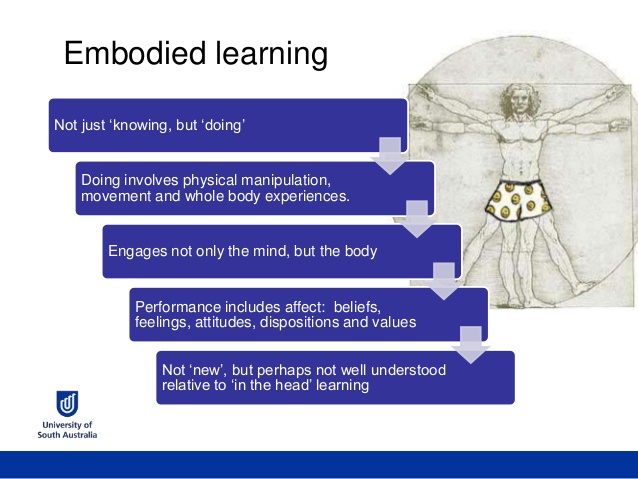Metacognition and Embodied Learning
Metacognition
Metacognition, a term that was
first defined by John H. Flavell in 1979, is
basically thinking about thinking. With metacognition, we become aware of our
own learning experiences and the activities we involve ourselves in our paths
toward personal and professional growth. We are better able to understand
ourselves in the whole process of learning and can develop skills to think
about, connect with, and evaluate our learning and interactions each day. According
to Flavell, metacognitive knowledge is
“knowledge about one’s own cognitive processes or products.
Metacognition has been identified as an essential skill for learner success. It
allows students to drive their learning, build student agency, and
foster a growth mindset in learning.
In order to develop metacognitive skills and
habits in the classroom
•
First, students must have the opportunity to practice and so must be
placed in situations that require metacognition. They should know the meaning
and importance of metacognition, and the development of the capacity for it
must be an explicit goal for both teacher and student. This goal must have a credible and enduring presence in the established
curriculum and in assessments.
•
Second - connecting to Vygotsky's teachings -metacognition can and should
be modelled. When a teacher "thinks aloud," particularly during
problem solving, his or her verbalizations can be a powerful source of
cognitive processing that can be internalized by students. This has been called
cognitive modeling, or "making thinking audible."
•
Third, just as teachers should model metacognition, social interaction
among students should be used to cultivate their metacognitive capacity. If
students are encouraged and guided to think critically together, then their
spoken reasoning will ideally make their cognitive tools available to one
another.
In metacognitive learning a key challenge for teachers is being able to recognise how well their students understand their own learning processes.
References
Flavell, John H. 1979. “Metacognition and Cognitive
Monitoring: A New Area of Cognitive-Developmental Inquiry.” American
Psychologist 34 (10): 906–911.
Descartes was the first to
formulate the mind–body problem in the form in which it exists today. Dualism is the view that
the mind and body both exist as
separate entities. Descartes / Cartesian dualism
argues that there is a two-way interaction between mental and physical
substances. Descartes argued that
the mind interacts
with the body at the pineal
gland. Descartes described on one
side the body as a material “machine” containing organs and following the laws
of nature. On the other side, he described the mind
as non-material and independent of the laws of nature. The interaction between body
and mind would be enabled by the pineal gland, the “seat of the soul.”
Rationalism has strongly influenced cognitive sciences in the
20th century. Fodor et al. (1974) described the
mind as a set of computational operations subdivided in modules that are
defined in terms of their function. Originally, Fodor saw no connection between
a module and the reference world outside. He separated the mind from the body in the
manner of Cartesian philosophy. This was the core
idea behind the view that, when acquiring knowledge, we sit quietly and concentrate on
our “mental” task(s). With the advent of
neuroscience, Rationalism has been greatly challenged. Theories of embodied
cognition suggest that the mind is not an abstract and isolated entity. Rather the mind is integrated into the
body’s sensorimotor systems. The embodied view
of cognition is grounded in sensory and motor experiences (Engel et al., 2013; Mahon and Hickok,
2016).
Embodied learning refers to pedagogical approaches that focus on the
non-mental factors involved in learning, and that signal the importance of the body and feelings. Embodied Learning constitutes a
contemporary pedagogical
theory of learning, which emphasizes
the use of the body in the educational practice and the student-teacher interaction both
inside and outside the classroom and in digital environments as well.
Embodied learning is;
- · Experiential
- · Practical
- · Hands on
- · Physical
- · Activates cognitive, affective and somatic dimensions
In accordance with the constructivist principles, the body is used
both inside and outside classroom for experiential learning and is not treated
as a place of learning. The principles of Embodied Learning provide answers to
questions related to the ways knowledge is constructed by students as they
leave behind them the academic model of perceiving knowledge and treat each
student as a whole, while they view everyone’s body as a tool for knowledge
construction and as a knowledge carrier.
References:
Asher, J. J. (1969). Total physical
response technique of learning. J. Spec. Educ. 3, 253–262. doi: 10.1177/002246696900300304
Fodor, J., Bever, T. G., and
Garrett, M. F. (1974). “The psychology of language,” in An Introduction to Psycholinguistics and Generative Grammar, eds J. A. Fodor,
T. G. Bever, and M. F. Garrett (New York, NY: McGraw-Hill).
Engel, A. K., Maye, A., Kurthen,
M., and König, P. (2013). Where’s the action? The pragmatic turn in cognitive
science. Trends Cogn. Sci. 17, 202–209.
doi: 10.1016/j.tics.2013.03.006
Mahon, B. Z., and Hickok, G. (2016).
Arguments about the nature of concepts: symbols, embodiment, and beyond. Psychon. Bull. Rev. 23, 941–958. doi: 10.3758/s13423-016-1045-2




Comments
Post a Comment